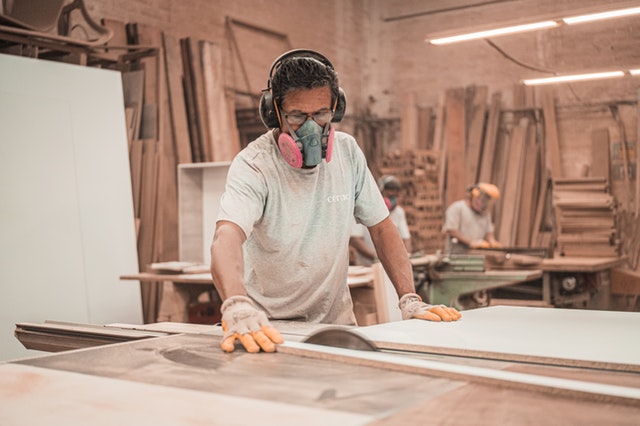How To Make A Perfect Finger Joint For Your Woodworking Project

Welcome to our latest woodworking tutorial, where we’ll be discussing one of the most fundamental yet impressive woodworking techniques: the finger joint. This joint is perfect for joining two pieces of wood together seamlessly, creating a strong bond that is both durable and visually appealing.
In this guide, we’ll be walking you through each step of the process, from selecting the right tools and materials to the final sanding and finishing touches, and on how to make a perfect finger joint for your woodworking project.
So whether you’re a beginner or an experienced woodworker, this guide will provide you with all the knowledge you need to create a perfect finger joint for your next project.
Today I’m Here to Teach You How to Make a Perfect Finger Joint

Welcome woodworkers and aficionados of the craft! It’s your favorite teacher, here to tell you how to make the perfect finger joint.
This process may look intimidating, but trust me – I have done his fair share of woodworking, from whittling to building a bird house for my granny. The key to making the perfect finger joint is in the preparation. You’ll need three core tools: a sharp handsaw, a chisel, and a hammer. It’s also important to have sandpaper, measuring tape, and a pencil to hand. Once you have your materials, you can move onto the fun part – making the perfect cut!
Making the perfect cut is about accuracy and precision. To begin, measure out the finger joint’s length, thickness and width. This is your road map for the sawing. For the tightest possible fit, make sure the cuts are perfectly straight – if you’re having trouble keeping the saw steady, try laying a ruler against the wood to better guide your hand. Once you’ve made the two cuts, check they match up. If they don’t, grab the chisel and start shaving off the spots where they don’t fit. Be careful with the chisel – you don’t want to break the finger joint.
When you’re happy with the fit, use the chisel to shape the ends of the finger joint together. The edges should be about a quarter of an inch deep and it’s important to stay close to the lines you marked out earlier. Using a mallet, tap the chisel until the joints are evenly aligned.
Once you’ve shaped the joint, use a coarse-grade sandpaper to rub away any excess wood and create a smooth finish. When you’re done sanding, you’ll have a perfectly made finger joint. If your joint is for outdoor use, consider coating it with water-repellant oil to prevent it from rotting.
So there you have it – with a bit of preparation and a steady hand, you should have a perfectly made finger joint ready for your next project. Don’t forget: if things get too difficult and you’re having trouble following my instructions, turn to the master himself – YouTube. I wish you all the best with your woodworking projects and remember – stay safe and keep whittling!
What You’ll Need

Today we’re going to learn how to make the perfect finger joint for a woodworking project. Now, before we start, let’s take a look at what you’ll need.
First and foremost, you’ll need a good quality saw. Now, I’m no expert, so don’t take my word for it, but when it comes to finding the right saw, my advice is always the same – get the best saw you can afford! A good saw will make all the difference when it comes to getting clean, accurate cuts.
In addition to the saw, you’ll also need clamps, sandpaper, and some wood glue. Now, different types of wood require different types of glue, so make sure to double-check which type is right for your project before you buy.
And last but certainly not least, you’ll need some tape measure. Having an accurate tape measure is essential when it comes to getting an exact fit on your joint. You don’t want to be left with an “almost right” joint that won’t fit together once everything is assembled.
Well, that’s it for the things you’ll need to make the perfect finger joint. Now, let’s go ahead and start cutting!
Making The Perfect Cut
Ha ha ha! Hey you guys, it’s me again and today I’m here to teach you how to make a perfect finger joint! Making a perfect cut is the foundation of any great woodworking project, and with a few simple tools and a little bit of ingenuity, you can make it happen.
The first step is to get your woodworking tools in order. You’ll need a table saw and a router, preferably with a sharp carbide blade. Safety equipment like goggles, gloves, and a dust mask are also essential, as working with wood can be dangerous!
Once you have all the proper tools and safety equipment, you can begin to make the perfect cut. Take the stock you are working with and make sure it is level and straight. Then, clamp it down securely so that it won’t move during the cutting process.
Next, set up your table saw and router to make the cut. Take the stock and place it on the saw, using the fence and miter gauge to make sure the cut is lined up correctly. Make sure to use a push stick, as it will help keep your hands safe and away from the blade. Then, carefully cut along the edge of the template with your router. Use a steady hand, and be sure to keep the router cutting in a straight line.
Once you’ve made the cut, you can then fine tune it by sanding it with a power sander or a hand file. This will help to smooth out any rough edges or imperfections.
And there you have it! If you take your time, and pay attention to detail, you can create a perfect finger joint every time. Now that you know how to make a perfect cut, you’re ready to move on to the next step of your woodworking project. Good luck and happy woodworking!
Shaping

Ahhh shaping the finger joint. That’s when the magic starts to happen and you will inevitably fall in love with woodworking.
First, you need to separate each finger from the board. To do this, use a saw, chisel, or router. First, cut into each finger using the saw to the depth you want. If you are using a chisel, keep your chisel at a perfect 90 degrees angle to the board. Create a series of shallow — ¼ inch deep — cuts around 1 inch apart until you reach the correct depth. With a router or as an alternative, you can use a trammel or jig to create a perfect cut everytime.
Next, use a block plane and chisels to shape the fingers of the joint, creating a smooth and even surface. Use steady and consistent pressure and make sure to always keep the plane perpendicular to the wood surface. As you shape, check the fit of the joint with the mating pieces of wood.
Once the joint is shaped, it’s important to check the edge. Sweep a card scraper or chisel along the edges to check and make sure the edges are perfectly clean and unified. Make sure that no remaining splinters appear on the surface and that you don’t take off too much material from either side.
Now, you have a perfectly shaped finger joint ready to be assembled. Congrats! You are now ready to move on to finishing the joint.
Finishing

OK, so the final step to making a perfect finger joint is the finishing process. Now, if you asked me what the most satisfying part of woodworking is, I’d tell you that it’s the moment you finish your project. It’s like when you get to the end of a really good movie and you can just sit back, relax, and enjoy it.
Finishing a woodworking project is like adding frosting on a cake—it’s the best part. Such things as stain and varnish both need to be applied to protect the joint from water damage, sunlight, and other natural elements.
As for the joint itself, you want it to look as though it’s been professionally made. A little sanding and a quick rub down with some steel wool should do the trick. You want to make sure that the surface is as smooth as possible. If you find that there are still or tiny grooves or gaps, you may want to fill them in with some putty or some wood filler.
Another thing to keep in mind is to make sure that whatever kind of finish you decide to use, it’s designed specifically designed to be used on wood. That way it won’t peel, chip, or crack over time.
Finally, it’s important to remember to clean off any dust and debris before you begin to apply the finish. You don’t want any dust particles to interfere with its durability and appearance.
OK, so now you’re all set! Follow the steps listed above and in no time, you’ll easily have completed a perfect finger joint that you can be proud to show off. Of course, don’t forget to take some pride in your accomplishment—after all, you’ll have made it yourself!






